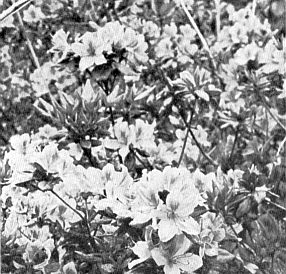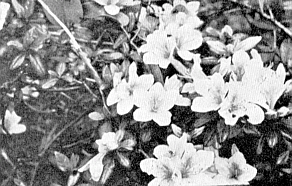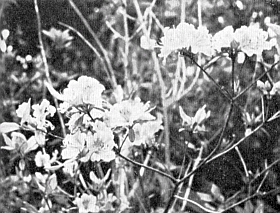QBARS - v28n4 Kurume Azaleas: The Past and the Future
Kurume Azaleas: The Past and The Future
Frank Doleshy, Seattle, Washington
One reason why the Kurume azaleas are so interesting is that their story leads back at least 150 years, and to source locations which have not been really pinpointed. The Kurumes could have been selected and developed from the wild plants at any one of three locations or, more probably, from all three places and perhaps other places as well. The problem with the wild ancestral plants is that there is no simple way to divide them into clear cut groups for naming. As a result, the sets of names found in current and older writings are varied and bewildering; they include R. kaempferi and its forms, R. kiusianum , R. sataense , typical R. obtusum , and its f. amoenum and f. japonicum .
These names will have to be reviewed a bit, and sorted out, but the reader will perhaps get more out of this review after he is better able to visualize the plants.
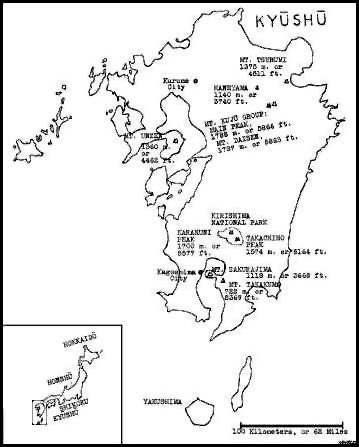
|
| FIG. 55. Map of Kyushu |
Kirishima
To see these plants, we must go to the south main island of Japan, Kyushu. And, within Kyushu, one of the focal locations is Kirishima National Park. To picture Kirishima, imagine that our Yellowstone National Park, with several added volcanoes, has been moved to southern Georgia; also try to imagine it as the birthplace of George Washington and as the place where his illustrious ancestors descended from heaven to earth to see to the founding of the Republic.
Turning to modern plant hunting history, it was to this place that E. H. Wilson was directed in 1918, when he wanted to see the wild forebearers of the Kurume azaleas. Here, he found a great swarm of multi-colored, more or less Kurume-like azaleas, and it was reasonable to accept the assurance that these were the source of the Kurumes. To get to these azaleas, Wilson traveled by train to a station some 15 miles from the Kirishima mountains, took a local conveyance to the foot of the mountains, then climbed on foot for a couple of hours. He probably made use of a trail which has been reworked into the road leading up from Kirishima Shrine to the present day visitor center at the foot of Takachiho Peak. In 1970 this was a pleasant little gravel road about 5 kilometers long, crooked and dusty, but with azaleas often hanging out over both edges. Perhaps it is now a paved high speed facility, but I hope not.
Taking a trip up, the starting elevation is only about 500 meters, and one of the most common plants is R. kaempferi, with its usual brick-red or salmon colored flowers - prized in other lands but dismissed by the sophisticated Japanese gardener as something about on a par with a dandelion. (So they talk, anyway.) The R. kaempferi near the lower end of the road is usually a large shrub or almost a small tree, perhaps because it is in a national park and more or less safe from digging or destruction. This azalea is common along the road as one goes higher, and practically all specimens up to 750 meters elevation could be accepted as ordinary forms of the species. However, there is a gradually increasing tendency toward deeper colors which are more nearly red than orange-red. Then, at about 800 m. (or slightly below), color variation explodes into a great variety of salmons, pinks, purples, and everything between. These are part of the famous Kirishima intermediate azaleas - a multitude of forms which bridge the gap from pure R. kaempferi to pure R. kiusianum. It was this assortment that amazed Wilson in 1918. At the 800 m. elevation, leaves vary in length from about 2 centimeters to 4 cm. or more. In the open meadows, plant height seems to be generally 1½ m - or slightly less, but heights are greater where growing under trees.
Still higher, along the same road, the orange-red and salmon hues drop out, bright reds are no longer conspicuous, and the most common colors are in the pink to rose range. Leaves also become smaller, but my recollection is that plant height remains almost unchanged. All of these characteristics are much the same along the remainder of the road, up to the barren, rocky flats around the visitor center, at ca. 960 m. elevation.
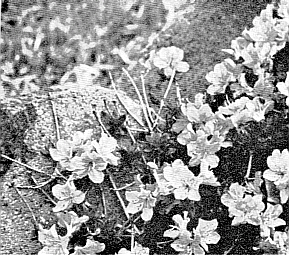 |
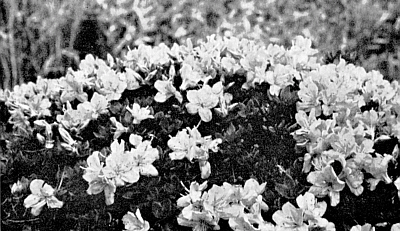 |
| FIG.56 R. kiusianum growing as a thin mat to the edge of the lava block and no farther. Ebino Plateau, Kirishima. Photo by Frank Doleshy |
FIG. 57. R. kiusianum growing at 1260 meters elevation, Ebino Plateau, Kirishima. This is the compact form found at higher elevations. Photo by Frank Doleshy |
From here, one of the main toll roads goes west then north to reach the Ebino Plateau, about 11 kilometers away. Elevations for the first several km. are mostly in the range of 900 to 1000 m., and the vegetation alternates between grassland and mountain woodland, the latter a pleasantly open forest with many red pines. The same tribe of azaleas continues along this road, with plant heights reduced to a meter or less, leaves smaller and more hairy, and flowers often clear pink, often rose-purple.
Swinging north, the road crosses a pass at about 1200 m., on the west slope of 1700 m. Karakuni Peak, then drops slightly and levels off on the Ebino Plateau. This was the destination when Mrs. Doleshy and I first visited Kirishima; we had been lured by a photo in a travel folder showing what appeared to be small compact, cushion shaped Rhododendrons scattered about on a pumice flat. These were the pure, unmixed R. kiusianum of high elevations, which I described in detail for the April, 1966, ARS Bulletin (pp.77-8). We have visited Kirishima twice more, during 1967 and 1970, and have also gone to Mt. Tsurumi, in northeast Kyushu. After viewing R. kiusianum in various situations, I can add that it is a remarkable rock-hugger, often spreading out like matting on a flat surface. In the last half of May, both the free-standing shrubs and the ones on the rocks are practically covered with flowers which are a nearly uniform rose-purple at the higher elevations.
Old and New Names
Two names have been mentioned so far; R. kaempferi, for the large, rather open-growing plants with salmon or orange-red flowers, and R. kiusianum, for the small plants of high elevations. These are today's standard Latin names in Japan and the names most often used by U.S. and British writers. However, a few years ago, this was not the case:
WILSON, from his examination of the azaleas at Kirishima, concluded that the boundary between R. kaempferi and R. kiusianum was so completely blurred by the intermediate plants that it was impossible to say where one ended and the other began. Therefore, he reluctantly decided that he could no longer treat the R. kaempferi and R. kiusianum as separate species. In A Monograph of Azalea, he described the whole tribe under the name of R. obtusum. He called the larger, salmon-flowered plants R. obtusum var. kaempferi, and (except for unusual sorts) he grouped the other wild plants together as R. obtusum f. japonicum. As for the typical R. obtusum and the f. amoenum, he considered these as nothing more than garden forms selected for flower color.
RENDER followed these views quite closely when he described R. obtusum in The Species of Rhododendron.
DR. HIROSHI HARA and other Japanese botanists did not accept this consolidation of the plants we now know as R. kaempferi and R. kiusianum. In the 1948 RHS Rhododendron Year Book, DR. HARA wrote of them as separate species and stated: in such a group as Azaleas, which have differentiated into many closely allied forms in a rather recent age, I think we may treat as separate species the wild plants which are distinguished by easily recognized morphological characters and which occupy separate geographical areas. He also pointed out that a wild plant exactly corresponding to the R. obtusum, of gardens, had not been observed, and he suggested that the cultivated plant may be a hybrid.
COLLINGWOOD INGRAM, in the 1956 RHS Rhododendron and Camellia Year Book, also opposed the idea that R. kaempferi should be merged with the high-elevation plants. But, for the latter, he continued to use the ambiguous name of R. obtusum.
DR. JOHN L. CREECH, in the account of his 1961 expedition, discussed R. kaempferi and R. kiusianum as separate species and said that he had seen no locality where they are so intermingled that I would wish to relegate these species to subspecific status on the basis of continuous distribution. (ARS Bulletin, January, 1967, p. 5.) He also treats R. obtusum as a superseded name.
DR. JISABURO OHWI, in his monumental Flora of Japan (In English), treats the two species as separate and also states that R. obtusum is widely cultivated and probably of hybrid origin involving R. kaempferi and several other species.
This lengthy review, I hope, will help the reader unravel any confusion caused by encountering the names used in the older literature.
Salcurajima Volcano
The next stop on the traditional tour of the sources of the Kurume azaleas is 1118 m. Mt. Sakurajima. This active volcano is less than a 4 km. ferry ride from Kagoshima, and it looms high over this city of 330,000. Our attempt to see the azaleas there, in 1970, was not very productive. After an hour of debate with the volcanologists at the observatory on the side of the mountain, they agreed to take a chance and let us do a little climbing without being halted by the police, provided that we stay on the slopes in view of the observatory. This was frustrating. At least twice, as we walked up the abandoned road, we looked at cliffs above us and saw azaleas with rose-colored flowers like some of the Kirishima intermediates, but we could not reach them without going behind a ridge which would hide us from the observatory. Yet I must admit that the people there were honest in their concern. We crossed places where the soil was sagging, apparently above recently-opened gaps in the rock beneath, and the new leaves on many of the sapling alders had been scorched by the showers of lava or ash.
In place of personal observation, I must substitute the information published by Dr. Creech in U.S.D.A. publications and the ARS Bulletin, and the information furnished to us verbally by Mr. Kunishige, of the Kurume Horticultural Station. Chronologically, Dr. Creech's account is based on his field work through 1961, and we have visited Mr. Kunishige in October, 1967 and May, 1970.
Dr. Creech states: The slopes of this active volcano are so covered with fresh lava rocks from constant eruptions that the upper portions do not support a forest cover. Yet, among huge lava boulders, azaleas thrive in profusion and present a variable array of colors from light pink to strong, reddish purple. I spent the entire day of April 24 wandering the paths that wind around the slopes of Sakurajima trying to draw some conclusions. Rhododendron kaempferi is the most prevalent species, readily distinguished by its loose, upright habit, flat to concave, elliptic leaves, and orange-red flowers, up to two inches across. A swarm of types closely resembling the Kurume azaleas in flower color and plant habit also grows here. Among brittle lava blocks also grows an azalea that has lavender flowers similar in size to those of R. kaempferi. Some Japanese refer to this azalea as R. obtusum... Studies by Japanese horticulturists suggest that the majority of azaleas scattered over Sakurajima are hybrids between this azalea and R. kaempferi. In all my visits to Sakurajima, no azalea similar to R. kiusianum, which inhabits the upper limits of Mt. Kirishima, could be found and the taxonomic status of the azaleas of Sakurajima is still a question.
Mr. Kunishige probably has a more thorough knowledge than anyone else of the Kyushu azaleas. Also, for a time, he took his family to Washington, D.C. and worked with Dr. Creech, who did us the great favor of making the long distance introduction. Our conversations with Mr. Kunishige were extremely interesting and included tours of his extensive azalea collections at the Kurume Horticultural Station, where they are planted in the form of a map of Kyushu.
His interpretation of the Sakurajima azaleas differs from that of Dr. Creech, but the difference is chiefly a matter of names, and reflects their two ways of classifying the Sakurajima azaleas which resemble the Kirishima intermediates. These Sakurajima plants have various flower colors, including purple, but they differ from the Kirishima plants in that they have more smooth and shining (less hairy) leaves, which tend to be of more consistent size. Kunishige calls these R. sataense, a name which meant little to us until we saw plants at the Kurume station during our 1967 visit. As Kunishige points out, this species differs greatly from typical R. kiusianum, and he believes that it could reasonably be considered an ecological variant of R. kaempferi, favoring an open habitat instead of the usually shaded habitats of typical R. kaempferi. It is apparently quite widespread in the mountains from Sakurajima southward, on the Osumi Peninsula, but it tends to inhabit a narrow range of elevations at any particular location, e.g., 700-800 meters. It takes its name from Cape Sata, at the south end of the Osumi.
During our 1970 visit, Kunishige showed us growing specimens of R. sataense in a wide range of salmon, pink, rose, lavender and purple colors, and he pointed out the very close resemblance to the cultivated Kurume azaleas - probably closer than the traditional and widely-accepted resemblance of the Kurumes to the Kirishima intermediates. He told us that we should find R. sataenseif we managed to get up onto the north slopes of Sakurajima (which, as mentioned, we did not). However, he said that he had climbed to the limit of vegetation on the south side of Sakurajima without finding R. sataense - instead, only R. kaempferi. Also, he had not seen any R. kiusianum on this mountain, and he thought that there may indeed be none.
These accounts of the Sakurajima azaleas add a new dimension to the problem of Kurume azalea ancestry. It is no surprise that R. kiusianum is lacking on this mountain, since it could well have been denied entry or exterminated by volcanic activity. Yet we have the R. sataense, which is obviously close to R. kaempferi but which also resembles the Kirishima intermediates - and these latter plants are regarded as natural hybrids between R. kaempferi and R. kiusianum. This leaves us somewhat up in the air about the origin of R. sataense (and, if the reader feels confused at this point, I can only say that he feels about the same as people who have studied these azaleas for years).
More about this later, after a look at the Takakuma Mountains, located a few kilometers southeast of Sakurajima. We understand that this is but one of several places on the Osumi Peninsula where R. sataense is abundant. However, it is more accessible than most of these other locations and is a well-known site in Japan; also it is known in America because of Dr. Creech's visit in 1961. Mr. Kunishige, in 1970, decided to send us there after phoning down from Kurume to find out where the flowering was at its best, and he was able to arrange for us to get on-the-spot directions from a nearby field station of Kagoshima University.
Azalea Fields on Takakuma
The Takakuma range is not volcanic but it seems to get much ash fall from Sakurajima. It is reached via Takatoge, a pass of about 565 m. elevation. Going up to this pass from sea level, one finds the common orange-red R. kaempferi. However, at least along the road from the west, this R. kaempferi seems to be absent from a belt of forest below the open, grassy highlands. In these highlands, above the pass, large plants of R. sataense are in sight almost everywhere.
|
||||
Near the road, one has the feeling that an effort has been made to improve on nature by moving in selected azaleas, spacing them carefully, and removing some of the Vaccinium, Ilex and Hydrangea. This is a nice show, but a more interesting area is found by climbing up and over a bald ridge and starting down the west side. Almost immediately, the trail enters a thicket of large R. sataense. As Mr. Kunishige had told us, these wild plants are only found within a narrow slice of elevations - perhaps 625-710 m. at this place. Yet in any open area within these limits, they seem to be completely indifferent to variations in exposure, steepness, soil mixture, or any other environmental circumstance, and they appear to be exuberantly competitive and invasive. One area looked like a group of old rice fields, separated by earth walls about 2 m. high, and buried under ash. The R. sataense had colonized the sides and tops of the walls and the flat fields between, apparently without preference. Along a power line maintenance trail they practically formed hedges. And, on a fairly flat area which was being reforested, these azaleas had apparently been slashed down to give the small Cryptomeria trees a better start, but they had grown back from the stumps as dense, rounded plants, covered with flowers; these could, I think, be entered in any Rhododendron show as Kurumes without raising an eyebrow, and they might win the awards. The color range was the now-familiar diversity of salmons, reds, pinks, roses and purples. Flowers sometimes formed a large cluster at the end of each branch, but they were more often scattered thickly on and within the foliage as on many cultivated Kurumes. Mature plants in the open were 1¼ to 2 m. tall, for the most part, but those partially within scrub woodland ranged up to 3 m. Other Azalea Mountains Takakuma completes the circuit of well-known azalea areas near Kagoshima, in southern Kyushu. However, in other parts of Kyushu, there are additional stands of wild plants resembling the Kurumes. Creech and Kunishige have mentioned the existence of R. kiusianum and R. kiusianum - R. kaempferi hybrids at Unzen, Mt. Haneyama, and Mt. Daisen (east peak of Mt. Kuju complex). Whether these played a part in the development of the older Kurumes is, I suppose, a matter of historical accident and accessibility. The people who today continue the development of new Kurume azaleas at the Horticultural Station are certainly able to use these additional stocks (unless they feel constrained to use only R. sataense as the source for Kurumes). Their collections of plants from these other locations are large and are very interesting because of the distinctive nature of each one. The Unzen R. kiusianum, from elevations no greater than the 1360 m. summit, are considerably different from the high-elevation (1000 m. plus) Kirishima plants. Those from Unzen grow larger, to about 1½ m., some flowers are a watermelon red or almost salmon, and some have a distinctive pink throat. Perhaps, one may speculate, the high-elevation R. kiusianum at Unzen was destroyed by the substantial volcanic eruption of 1792 (or an earlier one), and the R. kiusianum which migrated back into the higher areas was somewhat intermixed with R. kaempferi. Mt. Daisen is part of the highest mountain group in mainland Kyushu, and the R. kiusianum from this mountain, as cultivated at Kurume, is low growing and has flowers of a cool violet color. Dr. Creech also notes that Daisen is a place where white-flowered forms are found (but it should not be assumed that these are frequently seen, since Mr. Kunishige tells us that their field people usually manage to find only a few new white-flowered plants per season). Mt. Haneyama differs from all the other places discussed because it is not a volcano or ash field. Instead, it is structured from the immense flows of andesite lava which make up much of northeastern Kyushu. The R. kiusianum on this mountain is notably compact in habit; intermediate, pink-flowered plants growing at the very moderate elevation of 500 m. are small and dense, and they retain this habit even when transplanted to the broad, lowland valley where Kurume is located. Mr. Kunishige states that the Haneyama R. kiusianum is the best there is, and we cannot disagree. Perhaps the reason for the consistent low-growing habit is that this colony has never been destroyed by volcanic activity in the higher part of its home mountain and thus retains the original characteristics of the species. Differences in Geographical Distribution We have reviewed all the stands of wild azaleas which are likely to have contributed to the development of the Kurumes. Now we can take a look at the geographical limits of the territory where each species is found, and this may turn up some information of interest to the breeder of azaleas. First, there is R. kaempferi, found on the hills and mountains of all four main islands of Japan. Growing on the lower peninsulas of Kyushu, it is at the latitude of southern Georgia or the boundary area of western Mexico. And, growing from bottom to top of 811 m. Mt. Apoi, Hokkaido, it is at the latitude of Boston or southern Oregon. It is very common and variable; besides the usual orange-red or salmon, white forms have been found, but kaempferi like purples are fairly certain to be hybrids. Mr. Wada has reminded me that some interesting kaempferi affiliates with variable flower color grow in the wild on the main island of Honshu, between Hamamatsu and Nagoya. These may be the source of certain cultivated azaleas resembling the Kurumes. However, with regret, I have to consider these beyond the scope of the present discussion. Our second species is R. kiusianum; this, the authorities agree, is limited to the higher mountains of Kyushu only. The compact form with uniform, rose-purple flowers apparently is found only above 900 or 1000 m., although forms or hybrids with compact habit and variable flower color are found lower on Mt. Haneyama. We have talked with several Japanese plantsmen about the reason for this distribution pattern, and the general opinion is that R. kiusianum was at one time distributed throughout Kyushu but now survives only on the high mountains as a resu1t of climatic change. One change which suggests itself is the warming trend at the close of an ice age, but it is hard to see how this would explain the extraordinary retreat of R. kiusianum, which is cultivated with success in the warm climate of Kurume. A better explanation, I think, is that the mountain top or polka dot distribution came into being at a time when heavy, continuous tree cover allowed little light to reach low-level shrubs, and survival was a matter of being able to spread quickly onto areas denuded by volcanic eruption or land slippage. If this explanation is correct, the scattered stands may be the survivors of a cold period, with conifer forest replacing open grassland and shrub land.* *Another interpretation is possible, i.e., that R. kaempferi and R. kiusianum are simply two extreme phases of an assemblage of plants which share a common pool of genes (or, roughly speaking, are a single species). This would be close to Wilson's views and, also, would make it easy to explain why R. kiusianum survives in active volcanic areas; we could say that it migrates back from the common pool after being destroyed on a mountain top, and that the low-growing plants are the ones sorted out by ecological factors as it climbs back up the mountain. I used to favor this interpretation, but there are two things wrong with it. First, it does not account for the remarkable uniformity of R. kiusianum on the highest mountains of Kyushu; second, it fails to explain why there is no such thing as R. kiusianum on high peaks outside of Kyushu, even where the surrounding hills are full of R. kaempferi. Next, we need to consider the Kirishima intermediates and the similar intermediates at Unzen, Haneyama, Kuju, and probably elsewhere. These are generally attributed to natural hybridization of R. kaempferi and R. kiusianum, and I must agree, since no other explanation appears to account for these plants. R. sataense does not differ a great deal in general appearance from the Kirishima intermediates, but it is treated by the Japanese azalea specialists and by Dr. Creech as a somewhat different entity. As mentioned, Mr. Kunishige suggests that it can perhaps be considered an ecological form of R. kaempferi, Present-day opinion seems inclined toward use of the R. sataense name for all of the Osumi Peninsula plants which resemble R. kaempferi but have smooth and generally smaller leaves and varying flower colors (i.e., considerable diversity outside of the orange-red and salmon range). If R. sataense can, indeed, be considered an ecological form of R. kaempferi, it is difficult to see how the separation could have taken place in today's environment. As Mr. Kunishige points out, R. sataense usually grows in more open, sunny places than R. kaempferi. Yet, at present, the two are found in such close proximity that it would be hard to imagine the emergence of distinct races in response to local conditions. Instead, it would seem that they must have developed their distinctive characteristics at a time when they were more effectively isolated from each other. One possible explanation is that the R. kaempferi on the Osumi Peninsula was cut off by the huge pumice flows from a vent about 10 km. north-northeast of present-day Mt. Sakurajima. According to Kuno, in Catalogue of the Active Volcanoes of the World, these flows covered an area not less than 120 km. by 100 km., to a depth of 100 to 200 m. (no surprise to anyone who has looked at road cuts and stream banks near Kagoshima). The result may have been a long-lasting barrier which allowed the cut-off R. kaempferi to evolve into the fairly distinct and stable new race we call R. sataense. However, more favorable conditions eventually allowed ordinary R. kaempferi to cross the barrier, and this latter plant is now widespread on the peninsula. Hardiness: A Plan for Action The Kurume azaleas perform admirably in warmer parts of Britain and in much of the U.S., including sunny portions of Seattle and Portland gardens. However, most of them don't seem to have a great deal of tolerance for cold or dark weather, and British writers have mentioned a failure to set flower buds unless planted in a warm location. This suggests that they are largely the offspring of wild plants which evolved in a warm, sunny climate - and R. sataense may well be such a plant. Yet, among the individual Kurumes, quite substantial differences in hardiness have been reported. This suggests the interesting possibility that a Kurume which is primarily derived from the Kirishima intermediates, instead of R. sataense, may be more tolerant of cool summers and cold winters. Obviously, testing for temperature tolerances should continue, and the whole group of Kurumes will be more useful when we are more certain of the ones adapted to particular climates. Also, carrying this approach further, why not a new group, specially bred for the cool climates of eastern Scotland, Scandinavia, and portions of the U.S. and Canada? Immediately, I must add that I am aware of the hundreds of existing clones-probably hundreds too many. Yet, if it is possible to develop a Kurume-type race for growers in these cooler climates, there is no reason why they shouldn't have such plants. A developmental plan with every chance of success would be to take far-northern R. kaempferi, perhaps from an elevation of several hundred meters in the cold, foggy Hidaka Mountain Range of central Hokkaido (at the latitude of New England), and cross this with high-elevation forms of R. kiusianum. Neither of these parents should cause any problems of heat demand in summer or winter. Yet this would be nothing more than a new version of the hybridization which is considered to have yielded the Kirishima intermediates and, perhaps, a portion of the Kurumes. The resources for making such crosses are probably at hand now, in this country. Dr. Creech, in 1961, made no less than seven collections of R. kaempferi plants in Hokkaido, under USDA Plant Introduction Numbers 276093-276097 and 276141-276142. Or, if these plants are widely dispersed and now difficult to locate, there should be no special difficulty in getting replenishment stocks from the same Hokkaido areas. The ordinary, high elevation rose-purple R. kiusianum is in ample supply, at least in the Seattle area, from seed collections by Mrs. Doleshy and myself: No. 8, from pumice flats of Ebino Plateau, Kirishima, and No. 37, from summit of Mt. Tsurumi. White-flowered clones are available commercially, and all the ones we have seen appear to be high-elevation P. kiusianum. Also, beautiful pink-flowered selections are little known in the U.S. but apparently popular in Japan, and these should certainly be included in the program. The seeds from these crosses should be grown from the beginning in the cool-summer or cold-winter localities where the new strains are particularly needed. Testing will thus begin when the small plants are moved out-of-doors, and there will be no mistake as to the attainment of hardiness or bud-set objectives. In selecting clones, it would be highly desirable for the Kurume Research Station and/or the U.S. Department of Agriculture to act as referee, in order to prevent any more of the confusion which has resulted from too many named clones of the Kurumes. This proposed new race is something for the future, and you, the reader, may be interested in selecting some Kurumes at present. Advice is plentiful in Rhododendron publications, general gardening books, and even the newspaper garden columns. I can add little. However, because of the differences in climatic adaptability, I'd recommend that you get well-informed local advice, rather than depending on recommendations from another part of the country or another part of the world. ACKNOWLEDGMENTS I wish to express appreciation to the following individuals for their comments and suggestions concerning this paper: J. F. Caperci, Seattle; Dr. J. L. Creech, Washington, D.C.; E. Dzurick, Seattle; Dr. A. E. Kehr, Washington, D.C.; M. Kunishige, Kumme; K. T. Lauhon, Seattle; B. M. Swenson, Seattle; K. Wada, Yokohama. Also, T. Takeuchi, of Kawasaki, contributed by sending new information. However, I retain responsibility for accuracy and also for all opinions and interpretations expressed herein. LIST OF SPECIES AND SYNONYMS, as interpreted by the author: KAEMPFERI Planch. YAMA-TSUTSUJI KIUSIANUM Makino. MIYAMA-KIRISHIMA obtusum (Lindl.) Planch. KIRISHIMA-TSUTSUJI =hybrids of natural or garden origin, involving KAEMPFERI and other species obtusum f. amoenum Wilson =selections of KIUSIANUM obtusum f. japonicum Wilson = KIUSIANUM or natural hybrids between KIUSIANUM and KAEMPFERI obtusum var. kaempferi Wilson = KAEMPFERI SATAENSE Nakai. SATA-TSUTSUJI (also perhaps called KIRISHIMA-TSUTSUJI in the past) VOLCONIC ACTIVITY DURING HISTORIC TIMES, compiled by the author, mainly from information in Kuno's Catalogue of the Active Volcanos of the World, Part XI: SAKURAJIMA. Records of frequent eruptions extend back to AD 708. Much of the surface of the mountain, from summit to sea level, is a patchwork of the lava and other materials from these recorded eruptions. KIRISHIMA. Records of frequent eruptions extend back to AD 742. Apparently, only scoria and small, solid fragments have been ejected during this interval. Most eruptions have been at Ohachi crater, near Takachiho Peak; also, some have been at Shimmoe Peak, between Takachiho and Karakuni, and the April, 1946 eruption probably involved Karakuni. TAKAKUMA. Not a volcano; appears to receive substantial ash fall from Sakurajima. UNZEN. Records of eruptions extend back to AD 860. Lava extruded in 1657 and 1792. Violent 1792 activity caused 14,300 casualties on May 21st, from collapse of peak and resulting wave action in the sea. HANEYAMA. Not a volcano. KUJU. The only activity known with certainty in historic times is gas emission. TSURUMI. Latest eruption of blocks and ash was in AD 867; steam rose from old crater in 1949. SELECTED REFERENCES CREECH, J. L., Plant Explorations of Ornamentals in Southern Japan, U. S. D. A. Crops Research publication ARS 34-1, 1957. (Pub. by Agric. Research Serv. in cooperation with Longwood Gardens.) CREECH, J. L., Ornamental Plant Explorations - Japan, 1961, U. S. D. A. Crops Research publication ARS 34-75, 1966. (Pub. by Agric. Research Serv. in cooperation with Longwood Gardens.) CREECH, J. L., Ornamental Plant Explorations - Japan, 1961, Quart. Bulletin Amer. Rhod. Soc., 21: 2-9, January 1967. HARA, H., Occurrence and Distribution of Rhododendrons in Japan, Royal Hort. Soc. Rhododendron Year Book, 3: 112-127. 1948. INGRAM, C., Is Rhododendron kaempferi a Good Species?, Royal Hort, Soc. Rhododendron and Camellia Year Book, 10: 28-30. 1956. KUMAZAWA, S., Kurume Azalea. 25 pp., illus., 1958. Photo-reproduced; distributed by Kumme Branch, Horticultural Research Station, Miimachi, Kumme, Japan. KUNG, H., Catalogue of the Active Volcanos of the World including Solfatara Fields, Part XI, Japan, Taiwan and Marianas. 332 pp., maps and diagrams. Rome, International Ass'n. of Volcanology, 1962. MAKING, T., (Rewritten under Maekawa, Hara, Tuyama), Makino's New Illustrated Flora of Japan. 1149 pp., illus. Tokyo, Hokuryukan Co. Ltd., 1962. (In Japanese.) OHWL, J. Flora of Japan (in English). 1067 pp., some illus. Washington, D.C., Smithsonian Institution, 1965. STEVENSON, J. B., ed., The Species of Rhododendron, 2nd ed. 861 pp., some illus. London, The Rhododendron Soc., 1947. TAKAI, F., MATSUMOTO, T., and TORIYAMA, R., Geology of Japan. 279 pp., maps and diagrams. Tokyo, Univ. of Tokyo Press, 1963. Esp. see part 10, The Quaternary. WILSON, E. H., and REHDER, A., Publications of the Arnold Arboretum, No. 9, A Monograph of Azalea. 219 pp. Cambridge, Mass., The University Press, 1921. WILSON, E. H., Plant Hunting: Vol. II, The Tropics; The Orient. 276 pp., illus. Boston, The Stratford Co., 1927. (Also, my own accounts of trips to Japan are in various issues of the Quarterly Bulletin American Rhododendron Society, beginning in volume 20, 1966.) by Elliot Garner | ||||
